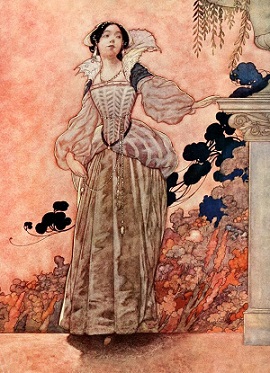| SONNET 130 |
PARAPHRASE |
| My mistress' eyes are nothing like the sun; |
My mistress's eyes are nothing like the sun; |
| Coral is far more red than her lips' red; |
Coral is far more red than her lips; |
| If snow be white, why then her breasts are dun;
|
If snow is white, then her breasts are a brownish gray; |
| If hairs be wires, black wires grow on her head. |
If hairs are like wires, hers are black and not golden. |
| I have seen roses damask'd, red and white, |
I have seen damask roses, red and white [streaked], |
| But no such roses see I in her cheeks; |
But I do not see such colors in her cheeks; |
| And in some perfumes is there more delight |
And some perfumes give more delight |
| Than in the breath that from my mistress reeks. |
Than the horrid breath of my mistress. |
| I love to hear her speak, yet well I know |
I love to hear her speak, but I know |
| That music hath a far more pleasing sound; |
That music has a more pleasing sound. |
| I grant I never saw a goddess go; |
I've never seen a goddess walk; |
| My mistress, when she walks, treads on the ground: |
But I know that my mistress walks only on the ground. |
| And yet, by heaven, I think my love as rare |
And yet I think my love as rare |
| As any she belied with false compare. |
As any woman who has been misrepresented by ridiculous comparisons. |
Notes
dun (3): i.e., a dull brownish gray.
roses damasked, red and white (5): This line is possibly an allusion to the rose known as the York and Lancaster variety, which the House of Tudor adopted as its symbol after the War of the Roses. The York and Lancaster rose is red and white streaked, symbolic of the union of the Red Rose of Lancaster and the White Rose of York. Compare The Taming of the Shrew: "Such war of white and red within her cheeks!" (4.5.32). Shakespeare mentions the damask rose often in his plays. Compare also Twelfth Night:
She never told her love,
But let concealment, like a worm i' the bud,
Feed on her damask cheek. (2.4.118)
than the breath...reeks (8): i.e., than in the breath that comes out of (reeks from) my mistress.
As the whole sonnet is a parody of the conventional love sonnets written by Shakespeare's contemporaries, one should think of the most common meaning of reeks, i.e., stinks. Shakespeare uses reeks often in his serious work, which illustrates the modern meaning of the word was common. Compare Macbeth:
Except they meant to bathe in reeking wounds
Or memorise another Golgotha,
I cannot tell. (1.2.44)
rare (13): special.
she (14): woman.
belied (14): misrepresented.
with false compare (14): i.e., by unbelievable, ridiculous comparisons.
Sonnet 130 is the poet's pragmatic tribute to his uncomely mistress, commonly referred to as the dark lady because of her dun complexion. The dark lady, who ultimately betrays the poet, appears in sonnets 127 to 154. Sonnet 130 is clearly a parody of the conventional love sonnet, made popular by Petrarch and, in particular, made popular in England by Sidney's use of the Petrarchan form in his epic poem Astrophel and Stella.
If you compare the stanzas of Astrophel and Stella to Sonnet 130, you will see exactly what elements of the conventional love sonnet Shakespeare is light-heartedly mocking. In Sonnet 130, there is no use of grandiose metaphor or allusion; he does not compare his love to Venus, there is no evocation to Morpheus, etc. The ordinary beauty and humanity of his lover are important to Shakespeare in this sonnet, and he deliberately uses typical love poetry metaphors against themselves.
In Sidney's work, for example, the features of the poet's lover are as beautiful and, at times, more beautiful than the finest pearls, diamonds, rubies, and silk. In Sonnet 130, the references to such objects of perfection are indeed present, but they are there to illustrate that his lover is not as beautiful -- a total rejection of Petrarch form and content. Shakespeare utilizes a new structure, through which the straightforward theme of his lover's simplicity can be developed in the three quatrains and neatly concluded in the final couplet.
Thus, Shakespeare is using all the techniques available, including the sonnet structure itself, to enhance his parody of the traditional Petrarchan sonnet typified by Sidney's work. But Shakespeare ends the sonnet by proclaiming his love for his mistress despite her lack of adornment, so he does finally embrace the fundamental theme in Petrarch's sonnets: total and consuming love.
One final note: To Elizabethan readers, Shakespeare's comparison of hair to 'wires' would refer to the finely-spun gold threads woven into fancy hair nets. Many poets of the time used this term as a benchmark of beauty, including Spenser:
Some angel she had been,
Her long loose yellow locks like golden wire,
Sprinkled with pearl, and pearling flowers atween,
Do like a golden mantle her attire,
And being crowned with a garland green. (Epithal).
How to cite this article:
Shakespeare, William. Sonnet 130. Ed. Amanda Mabillard. Shakespeare Online. 8 Dec. 2008. < http://www.shakespeare-online.com/sonnets/130detail.html >.
References
Petrarca, Francesco. Petrarch, the first modern scholar and man of letters. James Harvey Robinson, ed. New York: Haskell House, 1970.
Sidney, Philip, Sir. Selected writings of Sir Philip Sidney. Richard Dutton, ed. Manchester: Carcanet Press, 1987.
Tomlinson, Charles. The sonnet: its origin, structure, and place in poetry. Folcroft: Folcroft Press, 1970.
______
Even More...
 Shakespeare in Old English? Shakespeare in Old English?
 Shakespeare's Influence on Other Writers Shakespeare's Influence on Other Writers
 An Elizabethan Christmas An Elizabethan Christmas
 Clothing in Elizabethan England Clothing in Elizabethan England
 Queen Elizabeth: Shakespeare's Patron Queen Elizabeth: Shakespeare's Patron
 King James I of England: Shakespeare's Patron King James I of England: Shakespeare's Patron
 The Earl of Southampton: Shakespeare's Patron The Earl of Southampton: Shakespeare's Patron
 Going to a Play in Elizabethan London Going to a Play in Elizabethan London
 Ben Jonson and the Decline of the Drama Ben Jonson and the Decline of the Drama
 Publishing in Elizabethan England Publishing in Elizabethan England
 Shakespeare's Audience Shakespeare's Audience
 Religion in Shakespeare's England Religion in Shakespeare's England
 Alchemy and Astrology in Shakespeare's Day Alchemy and Astrology in Shakespeare's Day
 Entertainment in Elizabethan England Entertainment in Elizabethan England
 London's First Public Playhouse London's First Public Playhouse
 Shakespeare Hits the Big Time Shakespeare Hits the Big Time
|

More to Explore
 Introduction to
Shakespeare's Sonnets Introduction to
Shakespeare's Sonnets
 Shakespearean Sonnet
Style Shakespearean Sonnet
Style
 How to Analyze a Shakespearean Sonnet How to Analyze a Shakespearean Sonnet
 The Rules of Shakespearean Sonnets The Rules of Shakespearean Sonnets
 Shakespeare's Sonnets: Q & A Shakespeare's Sonnets: Q & A
 Are Shakespeare's Sonnets Autobiographical? Are Shakespeare's Sonnets Autobiographical?
 Petrarch's Influence on Shakespeare Petrarch's Influence on Shakespeare
 Themes in Shakespeare's Sonnets Themes in Shakespeare's Sonnets
 Shakespeare's Greatest Love Poem Shakespeare's Greatest Love Poem
 Shakespeare and the Earl of Southampton Shakespeare and the Earl of Southampton
 The Order of the Sonnets The Order of the Sonnets
 The Date of the Sonnets The Date of the Sonnets
 Who was Mr. W. H.? Who was Mr. W. H.?
 Are all the Sonnets addressed to two Persons? Are all the Sonnets addressed to two Persons?
 Who was The Rival Poet? Who was The Rival Poet?
_____
Did You Know? ...  "Of the countless editions of the works of Shakespeare that show a frontispiece likeness of the poet, it is a singular fact that by far the greater number favour the 'Chandos' portrait. The face and features of Shakespeare as 'imaged' in that portrait are those with which his readers are probably most familiar. It is not easy to account for this, since the Chandos Portraitportrait is certainly not the first in point of genuineness, whatever may be its degree of artistic merit. Possibly it satisfies more fully the popular ideal of the likeness of a great creative poet than does the bust or print just referred to. Be that as it may, the 'Chandos ' portrait, for various reasons, more than justifies its being kept in the custody of the nation as a very rare and valuable relic of its greatest dramatist." Alexander Cargill. Read on.... "Of the countless editions of the works of Shakespeare that show a frontispiece likeness of the poet, it is a singular fact that by far the greater number favour the 'Chandos' portrait. The face and features of Shakespeare as 'imaged' in that portrait are those with which his readers are probably most familiar. It is not easy to account for this, since the Chandos Portraitportrait is certainly not the first in point of genuineness, whatever may be its degree of artistic merit. Possibly it satisfies more fully the popular ideal of the likeness of a great creative poet than does the bust or print just referred to. Be that as it may, the 'Chandos ' portrait, for various reasons, more than justifies its being kept in the custody of the nation as a very rare and valuable relic of its greatest dramatist." Alexander Cargill. Read on....
|
_____
 Shakespeare on Jealousy Shakespeare on Jealousy
 Shakespeare on Lawyers Shakespeare on Lawyers
 Shakespeare on Lust Shakespeare on Lust
 Shakespeare on Marriage Shakespeare on Marriage
 Blank Verse and Diction in Shakespeare's Hamlet Blank Verse and Diction in Shakespeare's Hamlet
 Analysis of the Characters in Hamlet Analysis of the Characters in Hamlet
 Shakespeare on the Seasons Shakespeare on the Seasons
 Shakespeare on Sleep Shakespeare on Sleep
|

 "Of the countless editions of the works of Shakespeare that show a frontispiece likeness of the poet, it is a singular fact that by far the greater number favour the 'Chandos' portrait. The face and features of Shakespeare as 'imaged' in that portrait are those with which his readers are probably most familiar. It is not easy to account for this, since the Chandos Portraitportrait is certainly not the first in point of genuineness, whatever may be its degree of artistic merit. Possibly it satisfies more fully the popular ideal of the likeness of a great creative poet than does the bust or print just referred to. Be that as it may, the 'Chandos ' portrait, for various reasons, more than justifies its being kept in the custody of the nation as a very rare and valuable relic of its greatest dramatist." Alexander Cargill.
"Of the countless editions of the works of Shakespeare that show a frontispiece likeness of the poet, it is a singular fact that by far the greater number favour the 'Chandos' portrait. The face and features of Shakespeare as 'imaged' in that portrait are those with which his readers are probably most familiar. It is not easy to account for this, since the Chandos Portraitportrait is certainly not the first in point of genuineness, whatever may be its degree of artistic merit. Possibly it satisfies more fully the popular ideal of the likeness of a great creative poet than does the bust or print just referred to. Be that as it may, the 'Chandos ' portrait, for various reasons, more than justifies its being kept in the custody of the nation as a very rare and valuable relic of its greatest dramatist." Alexander Cargill.